
From graceful gliders to high-speed pursuits, bird wings show an incredible range of adaptability and evolutionary prowess. In today’s blog, we soar into the captivating world of flight and focus on the distinctive characteristics of diverse flying techniques and the beautiful birds who show us just how it’s done.
Birds are aerodynamic marvels, effortlessly taking to the skies with their unique wing and flight styles. The shape of a bird’s wing is determined by several factors, such as its size, weight, diet, habitat, and behavior. Differently adapted wing shapes create different types of flight; some species like seabirds need long narrow wings for soaring and gliding, using the wind over water to conserve energy and travel great distances. Most of the songbirds we see and those that live in tightly spaced environments like forests flap their wings to generate lift and propulsion and enable maximum maneuverability. Similarly, birds who need to dive for food, such as pelicans and terns, have long, pointed wings that help them to generate the speed they need when they dive into the water. Colder climates usually mean birds who live there have shorter, broader wings than those birds who live in warm climates, as shorter, broader wings are more efficient at trapping heat.
The evolution of these styles is a result of natural selection, as birds that were better adapted to their environment were more likely to survive and reproduce, passing on their dominant genes. Let’s take a look at three very diverse types of wings to explore those differences.

The Long Distance Gliders: Albatrosses
These majestic seabirds are the kings of gliding, renowned for their long, slender wings. With wingspans that can exceed 11 feet, albatross species are perfectly designed for soaring over vast oceanic expanses. Employing a flight technique known as dynamic soaring, they utilize the energy of wind currents to achieve sustained flight with minimal effort by harnessing the contrast in wind speeds at different altitudes. Albatrosses typically skim the ocean surface, at first using the wind generated by waves to gain initial lift. As they ascend, they transition to regions of stronger winds higher up, generating more additional lift by skillfully maneuvering between the different wind layers. By employing this energy-efficient strategy, albatrosses can cover vast distances without expending excessive energy.

The High-Speed Pursuit Artists: Hawks and Falcons
Hawks and falcons are renowned for their exceptional aerial agility and speed, enabling them to excel in a flying style referred to as high-speed pursuits. Rapid wing beats and swift, precise movements allow these formidable hunters to execute sharp turns and sudden dives with exceptional accuracy.
The common characteristic of these species are their short, broad wings that facilitate this rapid wing flapping. This design enables them to generate a significant amount of lift and propulsion, allowing for impressive bursts of speed. The ability to adjust the shape of their wings mid-flight further enhances their maneuverability, enabling them to navigate through dense vegetation or tight spaces effortlessly. When hunting, they also employ a technique known as stooping, where they execute a steep, high-speed dive toward their prey. During this rapid descent, these birds can reach astounding speeds, with peregrine falcons being known to exceed 240 miles per hour (386 kilometers per hour), making them the fastest animals on the planet when in a dive.

The Masters of Hovering: Hummingbirds
Among the most enchanting and remarkable birds, hummingbirds possess an extraordinary ability that sets them apart from all other avian species: the capacity to hover. Hummingbirds have evolved unique wings that incorporate a pronounced figure-eight motion, allowing for rapid oscillation, with some species beating their wings up to 80 times per second. This exceptional wing speed generates incredible lift, but crucially during both the upstroke and the downstroke, allowing them to maintain stability while hovering, and suspend themselves effortlessly in the air.
But hovering is a very energetically expensive way to fly, requiring a lot of muscle power and aerobic capacity, which means that this astonishing spectacle poses a ‘chicken and egg’ situation. Hovering enables them to stay still while extracting the food they need to fuel these high metabolic rates from nectar-rich flowers, but would they need to eat nectar if they didn’t have this flying style? This is a difficult question to answer, and it is likely that both factors played a role in their evolution.
It is possible that hummingbirds initially evolved the ability to hover in order to catch insects. Insects are also a high-energy food source, and they would have been an important part of their diet. However, as hummingbirds became more proficient at hovering, they may have also started to eat nectar. Nectar is relatively easy to digest, therefore hummingbirds can get a lot of energy from a small amount of food, and is a more reliable food source than insects, available year-round.
The diversity of bird flight styles is a testament to the incredible adaptations that have allowed avian species to conquer the skies, as each flight style is finely tuned to meet specific ecological needs and evolutionary challenges. By becoming familiar with the range of styles that are out there, we can develop greater appreciation for these remarkable aviators, gaining a deeper understanding of the natural world and the fascinating ways in which different species have mastered the art of flight.


